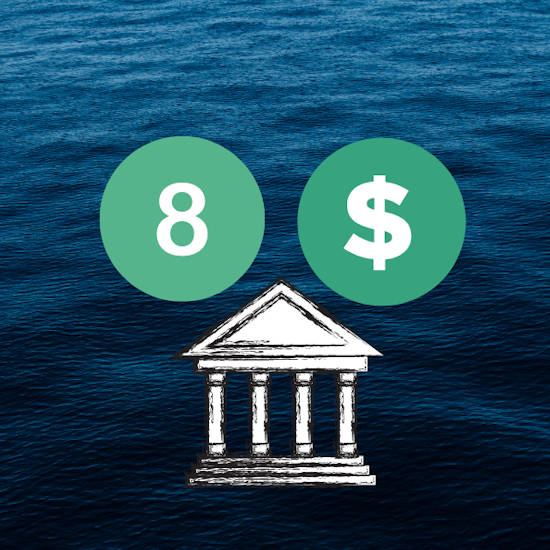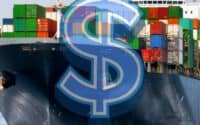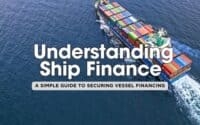8 Major Macro Factors Affecting Maritime Financing

Maritime financing isn’t just about buying a ship; it’s a complex dance of evaluating costs, risks, and returns. It involves diverse strategies like loans, leases, and bonds – all tailored to fit the colossal price tags of these sea giants. Whether you’re eyeing a sleek new tanker or a hefty bulk carrier, understanding the nuts and bolts of maritime financing is crucial.
* Please send feedback/suggestions to editor @ shipuniverse.com
Global Economic Growth and Maritime Industry
Interest Rates and Financing Costs
Exchange Rate Volatility
Trade Policies and Regulations
Oil Prices and Operational Costs
Technological Advancements and Competitiveness
Geopolitical Risks and Maritime Security
Environmental, Social, and Governance (ESG) Factors
Click here to find your ideal Maritime Financier
Why Macroeconomics Matters
But here’s the catch – the maritime world doesn’t float in a vacuum. It’s at the mercy of macroeconomic tides. Think global economic health, interest rates, trade policies, and oil prices. These giants don’t just influence market trends; they can make or break your financing plans. Navigating these waters requires a keen eye on how these economic behemoths play out on the high seas of maritime finance.
Global Economic Growth and Maritime Industry
Riding the Wave of Global Economy
The global economy and the maritime industry are like dance partners – when one moves, the other follows. A flourishing global economy means more goods to transport, more trade, and a higher demand for maritime transportation. It’s simple: as economies grow, they need more raw materials, more energy, and, of course, more consumer goods. All these travel largely by sea.
Take, for instance, a booming construction market in Country A. It needs steel, which Country B produces in abundance. The demand for bulk carriers to ship this steel skyrockets, and voilà, you see a direct impact on maritime transport demand. The catch? This demand isn’t static; it ebbs and flows with the global economic tide.
Economic Cycles: The Highs and the Lows
Economic cycles are like the ocean’s tides; they bring highs and lows. In a thriving economy, shipping rates soar. Everyone’s in a rush to move goods, and vessel space becomes as coveted as beachfront property. This increased demand pushes up the rates, making it a lucrative time for shipowners. It’s not just about higher profits; the value of ships themselves climbs. A tanker worth $30 million today might fetch 40 million in a peak economic cycle.
But remember, what goes up must come down. In a downturn, it’s a different story. Demand for shipping plummets, and with it, the shipping rates. That same $70 million tanker? Its value might dip significantly. This rollercoaster ride directly impacts your financing strategy. When rates are high, securing financing becomes more attractive; the potential returns look promising. But in a slump, lenders might be more hesitant, fearing lower returns.
Interest Rates and Financing Costs
The Interest Rate Anchor
Interest rates are like the anchor of maritime financing – they can either stabilize your plans or drag them down. The cost of financing ships is deeply intertwined with prevailing interest rates. Imagine you’re financing a $100 million vessel. A 1% decrease in interest rates could save you millions over the life of the loan. This saving isn’t just pocket change; it’s a significant factor in your financial planning and could mean the difference between a profitable venture and a struggling one.
Central Bank Policies: The Captain’s Wheel
Central banks steer the ship when it comes to interest rates. Their policies directly impact maritime lending practices. If a central bank tightens monetary policy and raises rates, financing costs go up. Lenders become more cautious, tightening their purse strings. In such scenarios, securing financing might require more collateral or higher credit ratings.
Conversely, if a central bank eases policies, lowering interest rates, the lending environment becomes more favorable. Banks are more willing to loan, and the maritime industry benefits from the influx of cheaper capital. Keeping an eye on these central bank policies is crucial for anyone looking to finance a ship.
Exchange Rate Volatility
Navigating Currency Storms
In the world of maritime finance, currency exchange rates can be as unpredictable as the sea. Most international trade and finance transactions are done in a few key currencies, like the US Dollar or the Euro. Fluctuations in these currencies can significantly impact your financing and operational costs.
Let’s say you’ve secured a loan in US Dollars, but your revenue is in Euros. If the Euro weakens against the Dollar, your income suddenly isn’t worth as much when it comes to repaying that loan. On the flip side, if your local currency strengthens against the Dollar, your loan repayments become cheaper in your home currency.
Understanding and managing this currency risk is crucial in maritime finance. Tools like hedging strategies and currency swaps are often used to mitigate these risks. It’s about being prepared, having a solid plan, and being ready to adjust your sails as the financial winds change direction.
Trade Policies and Regulations
The Winds of Trade Policies
Trade policies, tariffs, and embargoes are like the changing winds and currents in the ocean of maritime trade. They can significantly alter the course of maritime trade volumes. For instance, when a major trading nation imposes tariffs on certain goods, it can reduce the volume of those goods being shipped. This decrease directly impacts the demand for certain types of ships. If you’re in the business of shipping those goods, you might find your vessels underutilized, affecting your revenue and ability to repay loans.
Navigating Regulatory Seas
Regulatory changes, especially in the realm of environmental regulations, have profound financial implications in maritime finance. Take the International Maritime Organization’s (IMO) regulations on sulfur emissions, for instance. Complying with these regulations might require expensive retrofits like installing scrubbers or switching to cleaner, more expensive fuels. For a large fleet, these costs can run into the millions. This financial burden must be considered when financing a vessel, as it impacts the overall profitability and operational costs.
Oil Prices and Operational Costs
The Ripple Effect of Oil Prices
Oil prices are the waves that can really rock the maritime industry’s boat. As a major operational cost for vessels, especially for tankers and bulk carriers, fluctuating oil prices can significantly impact profitability. When oil prices rise, the cost of running a ship increases, squeezing the profit margins. For a tanker carrying millions of barrels of oil, even a slight increase in fuel costs can mean a significant hit to the bottom line.
Different Vessels, Different Impacts
The impact of oil price volatility isn’t uniform across all types of vessels. For instance, tankers, which transport oil, might actually benefit from increased oil demand and prices, as they often lead to more shipping activity. However, for bulk carriers and container ships, the equation is different; higher fuel costs mean higher operational costs, reducing profit margins.
When securing financing for a ship, it’s crucial to factor in these potential fluctuations in oil prices. They’re an integral part of the financial puzzle, influencing not just the day-to-day running costs but also the long-term financial viability of your maritime venture.
Technological Advancements and Competitiveness
The Tech Tide in Shipbuilding
The sea of shipbuilding and navigation technology is ever-evolving, and staying afloat means adapting to these changes. Technological advancements not only improve the efficiency and capabilities of vessels but also significantly affect financing decisions. For instance, investing in a ship with the latest eco-friendly technology might be more expensive upfront but can lead to long-term savings through lower fuel costs and compliance with environmental regulations.
When financiers assess a ship for financing, they’re not just looking at the price tag; they’re considering the vessel’s lifespan, operational costs, and potential future regulations. A ship equipped with cutting-edge technology may have a higher resale value and lower operational costs, making it a more attractive financing proposition.
Cost-Efficiency at Sea
The adoption of new technologies impacts the cost and efficiency of maritime operations. GPS and advanced navigation systems minimize the risks of accidents and optimize routes, saving both time and fuel. Automation in ship operations can reduce the crew size needed, impacting long-term operational costs. As these technologies evolve, the cost of implementing them decreases, making them more accessible for smaller operators, leveling the playing field in a competitive industry.
Geopolitical Risks and Maritime Security
Navigating Geopolitical Currents
Geopolitical instability looms as an additional factor in maritime financing. Changes in political climates, regional conflicts, or territorial disputes can lead to the rerouting of trade lanes, impacting shipping times and costs. These changes can be sudden and unpredictable, adding a layer of risk to maritime operations.
For example, a conflict in a region critical to global oil supply could lead to increased security risks and higher insurance premiums for tankers passing through that area. This increases operational costs, which in turn affects profitability and the ability to meet financing obligations.
The Cost of Keeping Safe
Maritime security threats, like piracy or terrorism, have a direct impact on financing and operational costs. High-risk routes necessitate additional security measures, such as hiring armed guards or investing in security equipment, which increases operational expenses. Insurance companies may also hike premiums for vessels operating in high-risk areas, affecting the overall financial planning for a ship.
In securing finance for a vessel, it’s crucial to account for these potential security risks and their associated costs. While they may not be everyday occurrences, their financial impact can be significant when they do arise, affecting both the short-term cash flow and the long-term sustainability of maritime operations.
Environmental, Social, and Governance (ESG) Factors
Charting a Sustainable Course
In today’s maritime world, ESG factors sail right at the forefront of financing decisions. The environmental aspect, especially, has gained significant traction. For instance, ships with lower emissions and better fuel efficiency are not just better for the planet; they’re also becoming more financially attractive. Financial institutions are increasingly favoring these eco-friendly vessels, aligning with global trends towards sustainability.
Social and governance aspects, though sometimes less highlighted, are equally vital. Social factors include crew welfare and working conditions, while governance deals with corporate practices and compliance. A shipowner with a strong record in these areas might find it easier to secure financing, as it indicates a lower risk of regulatory issues or reputational damage.
Maritime financing is not just about the numbers; it’s about understanding and navigating a sea of interconnected macroeconomic factors. By keeping a keen eye on these elements, industry professionals can steer their financing strategies towards more profitable and sustainable waters. Happy sailing!
Click here to find your ideal Maritime Financier
Additional References
- International Maritime Organization (IMO) – The IMO is a specialized agency of the United Nations responsible for regulating shipping. It provides information on global standards for the safety, security, and environmental performance of international shipping. Website: www.imo.org
- Baltic and International Maritime Council (BIMCO) – BIMCO is the world’s largest international shipping association, providing a wealth of information on maritime trends, policies, and market analysis. Website: www.bimco.org
- Maritime and Port Authority of Singapore (MPA) – Known for its advanced and efficient maritime services, MPA offers insights into port management and maritime economics. Website: www.mpa.gov.sg
- Lloyd’s List – A leading source of maritime industry news, analysis, and data, Lloyd’s List offers extensive coverage of shipping markets and finance. Website: www.lloydslist.com
- Clarksons Research – Providing comprehensive data on shipping markets and trade, Clarksons Research is a valuable resource for in-depth industry analysis. Website: www.crsl.com
- International Chamber of Shipping (ICS) – ICS offers a global perspective on maritime affairs, representing ship operators and providing industry guidelines and news. Website: www.ics-shipping.org
- The World Bank – Transport & Digital Development – The World Bank offers resources and reports on global transport sectors, including maritime trade and finance. Website: www.worldbank.org
- Maritime Economics & Logistics – A peer-reviewed journal offering in-depth analysis and research on maritime economics, policy, and logistics. Website: Maritime Economics & Logistics
- American Bureau of Shipping (ABS) – ABS provides classification services to the maritime industry, as well as research and publications on maritime safety and technology. Website: www.eagle.org
- The Financial Times – Shipping – For up-to-date news and analysis on the financial aspects of the maritime industry. Website: www.ft.com

Do you have a Maritime Product or Service that may be of interest to Shipowners? Tell us about it here!
Do you have feedback or insights? Please reach out to editor @ shipuniverse.com



